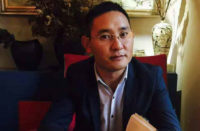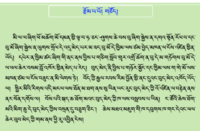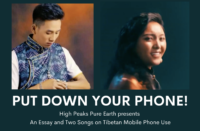
High Peaks Pure Earth presents the English translation of a post about Tibetan Hui Muslim communities in Hualong County in Amdo, that was originally published on the WeChat channel “Hualong Tibetan Voice” on November 14, 2017.
Hualong (Tb: Bayen, Palung) Hui Autonomous County is located in Haidong (Tb: Tsoshar) Prefecture of today’s Qinghai Province. It is one of several Hui designated Counties and Prefectures that can be found across the PRC today in several Provinces, including in Qinghai and Gansu.
The Hui people are the third largest ethnic group in the PRC after the Han and the Zhuang, they are predominantly Muslim. The post refers to a specific community called the “Tibetan Hui” in Bayen County and is a response to academic research done by Professor Yondrol K. Tsongkha of Lanzhou University.
A special thank you to Palden Gyal for this translation and be sure to scroll down to the end for the Translator’s Note and recommended further reading.
“Prejudiced Views Towards the ‘Tibetan-Hui’ of Hualong County”
Published on “Hualong Tibetan Voice” WeChat Channel
The day before yesterday, I accidentally came across a widely shared research article on Hualong “Tibetan Hui” identity in my WeChat Moments feed. It is titled, “The Transformation of the Cultural Identity of Hualong Bod-Hui (Tibetan-Hui),” and authored by Professor Yondrol K. Tsongkha of Lanzhou University, Centre For Studies of Ethnic Minorities in Northwest China. People who hear or come across topics related to “Tibetan Hui” for the first time entertain a sense of curiosity while reading such articles, and such papers, videos or images have a characteristic of seeking novelty. However, because many of the readers or onlookers do not really seem to understand the subject matter being discussed in the paper, and thus lacking the capability for discerning the content, they easily fall prey to and accept the partial and prejudiced views. After all, many people do not really recognize “the danger of a single story.” I had previously paid some attention to peculiar social phenomena and related research works on topics such as “Tibetan Muslims.” It is also because Hualong is my homeland and the place where I grew up. Therefore, after reading this research article, I cannot blindly accept or agree with the statements made in it.
Firstly, my impression of the paper when I first read it was that the author had already presupposed his own viewpoints even before conducting the research, i.e. those Hui who speak Tibetan are of Tibetan ancestry. The author makes an utmost attempt to persuade the readers to accept the view without leaving an iota of space for debate and discussion. All the references and works cited in the paper are from Tibetan documents that maintain the position of “Tibetan – Hui Muslims” and their origin and ancestry as Tibetan. The documents that the author cites are themselves well stocked with extremely prejudiced viewpoints. The author simply turns a blind eye to the good deal of research papers that maintain contrary views or those that are comparatively more objective. For instance, Tsedan (1983) refuted the paper “Islam in Kaligang: An investigation of Formerly Tibetan, Presently Hui” by Li Gengyan and Xu Likui (1982) in his paper, “Does Islamic Belief Alone Make a Hui?” In this paper, Tsedan retorts and refutes the claim made by Li Gengyan and Xu Likui that “those Muslims (Hui) who can speak Tibetan are of Tibetan origin and ancestry.” Similarly, Professor Chang Chung-Fu of National Chengchi University (Taiwan) published, “Historical Memory, Religious Consciousness and Ethnic Identity: An Investigation of the Tibetan Speaking Muslim Community in Kaligang, Qinghai.” Among the aforementioned research works, Professor Fu’s paper is comparatively more unbiased and objective, and it merits more attention from readers and researchers. But Tsedan’s views are also problematic for its limited scope of analysis. Although it is not sufficient to merely point out these two papers in rebuttal, but given the focus of Professor Tsongkha’s research paper, he simply could not neglect the views and works of these experts.
Professor Tsongkha’s paper is not the first one that concerns the “Tibetan Hui” phenomenon; this is evident from the paper itself. He claims “there are already over hundred research papers written by specialists in Tibetan Hui studies.” There are quite a number of research works related to the “Tibetan Hui” of Hualong, however, what is undeniable is that many scholars tend to repeat the same stereotyped patterns of study after a preceding scholar’s academic findings on a subject. They accept the earlier works almost unconditionally. This type or method of inquiry can neither make any substantial headway nor innovation in research (this paper by Professor Tsongkha is not an exception). Therefore, inevitably, it makes people to call into question the purpose of writing such papers that only serve to increase a scholar’s number of publications but fail to gain new grounds or push forward serious thought and study.
To briefly summarize, generally, those scholars who maintain “Tibetan Hui” to be of Tibetan origin and ancestry will roughly reason with and rely upon the following points:
1. During the reign of emperor Qianlong, Ma Laichi the founder of Flower Temple Menhuan who was a Sufi master and an Islamic missionary from Hezhou (present day Linxia, Gansu Province), arrived in the Kaligang region to preach and convert local Tibetans to Islam. [In reality, such stories are more or less popular folktales. There is no detailed historical record, only a walking stick that Ma Laichi supposedly used as a piece of evidence for his existence and arrival in this place.]
2. The reasons for Ma Laichi’s smooth and successful conversion of Tibetans to Islam during this particular historical period are that Tibetans in this region were badly afflicted by the Qing Government’s taxation and exploitation by local Buddhist monasteries. These circumstances created the conditions for smooth conversion. [Such statements clearly reflect an appearance of reason and good sense. But, if one considers the statement carefully, one finds that such accounts of double oppression demand doubt. Probe into some historical materials of the period, it won’t be difficult to verify the claims. Returning to the main issue, even if there was historical background to this account of double exploitation, were those converted to Islam thereafter not subject to Qing government’s taxation and not exploited by Buddhist monasteries?]
3. There is sufficient reason to believe that the ancestors of Tibetan-speaking Hui were Tibetan, but it is impossible that they were Muslims (Hui) or any other ethnicity. [This kind of viewpoints is obviously irresponsible. First, have anyone seen or heard a Hui person speak “Hui language”? If you have, I just want to say: “This is all caused by your all-nighters or sleeplessness, and you are experiencing auditory hallucinations.” Additionally, is it really feasible to determine or demonstrate the identity of an ethnic group based solely on its spoken language? Especially, under the circumstance of Hui people without a language of their own, what language do you want or wish them to use?]
4. Some local older generation “Tibetan-Hui” concede the belief that their ancestors were Tibetan. [When they narrate such tales passed down for a few centuries, do you just believe them? Do you not even entertain the slightest doubt about it? Is it possible for them to get rid off their cognitive dissonance of identity when they live and socialize in the cultural sphere of influence that places great importance to Tibetan culture?]
5. There is the element of traditional Tibetan architectural style. [Being isolated and disconnected from the rest of the world for many years, one cannot expect much from this remote and desolate region. With regard to adopting the regional culture and its architectural style, it is conceivable that the regional culture replaced and removed their indigenous style.]
6. Local Tibetan culture and custom: the examples include the singing of Tibetan folk songs, practice of archery, horse race, the celebration of Tibetan festivals and so forth. [Is it not possible for them to have followed and adopted the prevailing trends under the conditions of Tibetan culture as the mainstream culture like how urban people today emulate Western fashion? If the pursuit of certain aspects of the mainstream culture at that time meant the complete transformation of that ethnic community and its identity, then we must all doubt and question what our ethnic identities are today.]
7. The dressing of Tibetan costume as a proof of their Tibetan identity. [One must be aware that about twenty-thirty years ago, to stay warm in the cold climatic conditions, the only warm clothes (winter-clothing) they could get hold of was probably only Tibetan attire. During those days, the economic conditions did not allow one to possess clothes such as down-filled garments and leather jackets. They could only think about how to overcome the cold winters smoothly, but are not vexed and tormented by the thought of wearing the clothes and costume of another ethnicity. Therefore, please do your best to refrain from comparing their past circumstances to current economic and living conditions.]
8. Field research findings provide powerful evidence. [These studies only serve to sustain their established presumptions.]
All these articles that contend the ancestry of the so-called “Tibetan Hui” to be Tibetan do not put forward any substantial content and context with regard to the historical background of Hualong Tibetans, i.e. such methods of throwing out the larger context by dwelling on to discuss local histories does neither deserve admiration nor advocacy. Those who understand the situation must also grasp the contributions made by the presumed indigenous Tibetans of Hualong region to Tibetan history, Buddhist culture and so on. Here, I will not give an example, but I believe those who are truly interested will go and find out themselves. Perhaps, one of the main reasons why this is ignored and overlooked is that currently there is not a single relatively complete and thorough historical monograph about the Tibetans of Hualong. As educated individuals and scholars of Hualong, we must take this matter to be of great importance; otherwise, we will always be stuck in that situation of awkward embarrassment and finger pointing, without any forceful argument for rebuttal or refutation. Similarly, another pressing issue that’s been precipitated and provoked by the “Tibetan-Hui” issue is that some section of people now question and doubt the identity of Tibetans who are presently residing in the Hualong region. They even imagine and speculate about whether or not these Tibetans will be “Islamized” or become part of this “Tibetan-Hui” phenomenon in the future. Concerning the youth who do not know much about the history of their homeland, they are frequently attacked by similar questions of interrogation or suspicion. So much so that some even do not dare to say that they are from Hualong, afraid and unable to endure the ridicule and mockery of some people (examples of such incidents have occurred in this very surrounding environment too). In the end, the ones that are directly affected by this issue are the Tibetan youth of Hualong who are deprived of their national self-esteem as well as confidence in their daily life activities. Although they have the capability of achieving many things, such prejudiced attitudes drive them insecure and inhibited. Similar issues will continue to trouble and torment the Tibetan youth of Hualong in the future. As Tibetan youth of Hualong of this generation, it is crucial for them to actively engage in understanding and learning the history and culture of Hualong. It must not be brushed aside with an attitude of indifference and insouciance.
In conclusion, I neither wholly deny nor wholly affirm the claim that the ancestors of the Tibetan-speaking Muslims or Salar people in the Hualong region were Tibetan, because the existing research works on the subject are replete with dubious and doubtful points that demand further study and scrutiny. Especially, there is a critical need for a comprehensive study that takes into account and investigates the entire regional history of Hualong. We cannot discuss this issue by merely relying on some specific local histories departed and disconnected from its greater regional history. Like Professor Tsongkha’s contention to classify and categorize the Tibetan-speaking Muslims of Hualong community, in some parts of Gansu Province and Kaligang as “Tibetan-Hui” with the assumption and argument that their ancestors were Tibetan, such perspectives are exceedingly careless and negligent, and I cannot accept it. Having read thus far, perhaps some readers might expect that I offer a clear and straightforward “response,” i.e. whether or not the ancestors of those Tibetan-speaking Muslims or Salar ethnic people were Tibetan. I am afraid that I have disappointed them on this point. If this were something that I can give a “yes” or “no” response, then the subject of this research would not have become such a long-standing controversial topic. Even if I could give an affirmative or a negative reply, the presuppositions of my statement will also be prejudicial, at least with regard to the “Tibetan-Hui” issue of Hualong.

Translator’s note:
I have reproduced the titles of some articles cited in this paper from “Muslims in Amdo Tibetan Society: Multidisciplinary Approaches” (2015) by Marie-Paule Hille (Ed), Bianca Horlemann (Ed), and Paul K. Nietupski (Ed). In this book, Chang Chung-Fu also has a chapter, “Self-identity versus State Identification of “Tibetan-Speaking Muslims” in the Kaligang Area of Qinghai: An Ethnographic Analysis,” which argues that ethnographical studies indicate that Tibetan-speaking Muslims in Kaligang are of two origins: local Tibetans who were converted to Islam and Muslim immigrants from Gansu Province who adopted Tibetan language and customs. As the author of this paper underlines, Professor Chung-Fu also cautions against the overemphasis on the Tibetan language as the main criterion for ethnic or national identity. I highly recommend this book for those interested to further explore and understand the complexities of historical, linguistic, and ethnic makeup of the Tibetan borderlands.





Thank you for the translation Palden!